14 Annotation Jam Session (OER22 Workshop)
Note: These materials were created for a workshop at the April 26-28 OER Conference but are openly available for use by anyone. The activities make use of the web annotation available in this page.
An Annotation Jam Session: Adding Meaning, Examples, Discussion to the UNESCO Recommendation on OER
Workshop by Alan Levine, Open Education Global, Apr 28, 2022
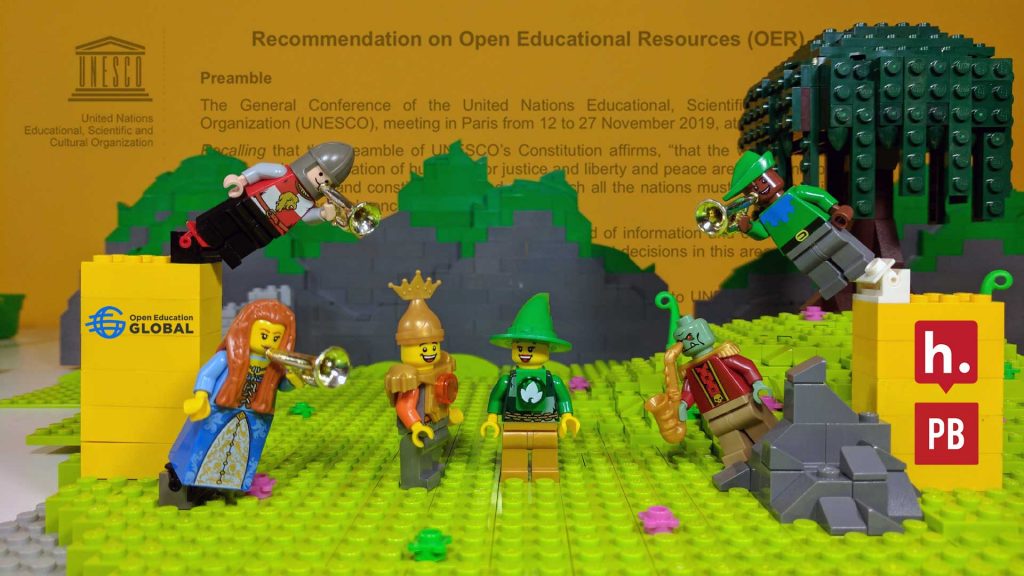
Workshop Description
Years in the making, the UNESCO Recommendation on Open Educational Resources (OER) justifies at a global scale the value and rationale for OER. The five action areas included in the Recommendation comprise a high level map for nations, governments, and institutions to follow towards implementation of the promise of open education.
While often referenced as a whole, the language of the Recommendation, because of the global scope, is very generalized and perhaps somewhat removed from every day practice. Can annotation help break down and clarify by the meaning and intent but also open critical perspectives?
The theme of September Open Education Global online conference was framed around the Recommendation as will be the 2022 in-person congress in Nantes, France. To create more understanding and create a series of bridging activities between these events, OEGlobal established a version of the Recommendation published in Pressbooks where the five language versions were set up to be automatically enabled for web annotation in with Hypothes.is. A series of asynchronous focus events were established to draw attention to he text of the five action areas.
The promise here is to attach examples, references, questions to the specific words of the Recommendation, all in the scope of both making it more concrete and understandable but also to organize regional differences and implementation challenges.
Annotation of many forms is an everyday act and a familiar one for educators and researchers (See Annotation by Kalir and Garcia, 2021). Web annotation is a readily approachable form of open pedagogy (Brown and Croft, 2020) for courses, but how does it fare as an open community practice?
The response so far for our call to annotate the Recommendation on OER has been relatively light. In this workshop style session, we question the value, purpose, potential of this annotation effort and itself as an academic practice. During the pandemic, web annotation seemed an ideal collaborative activity that did not require synchronous video sessions. But because web annotation is inherently a social process, this workshop is designed not as a led teaching session, but more like musician “jam” session, where participants can annotate individually or talk about their thinking together. Every presentation at OER22 ought to have a place to be attached to the UNESCO OER Recommendation.
The workshop will suggest a focus (but not limited to) on Action Area (iii) “Encouraging effective, inclusive and equitable access to quality OER.” We will explore what examples and practice support the specifics within the Recommendation, question what might be missing, or provide input on how implementation of this action area might include.
The UNESCO Recommendation on OER
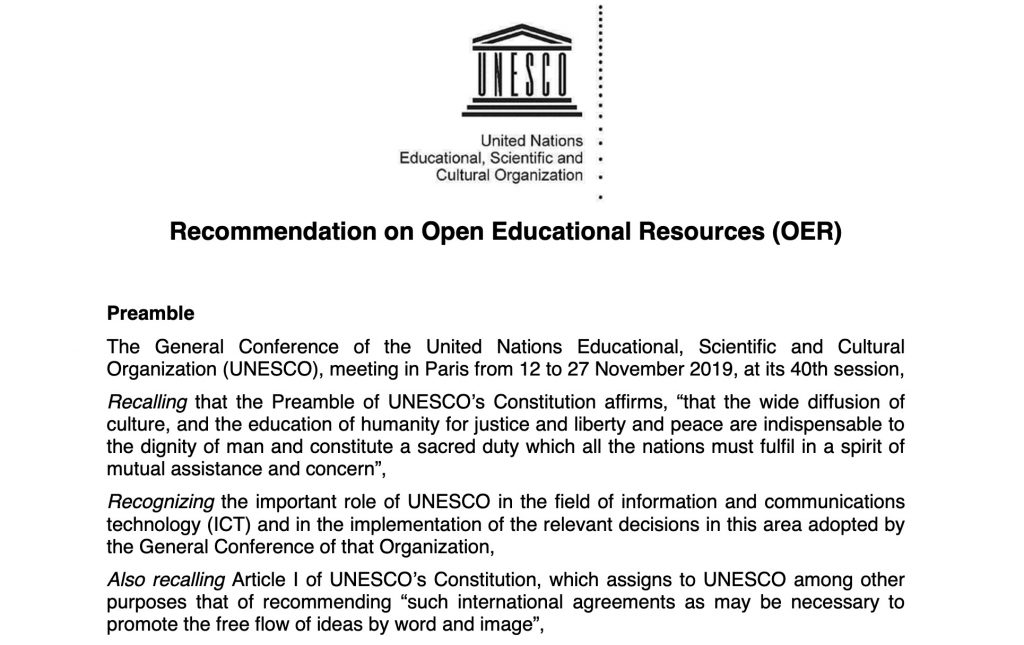
Action Area (ii): Developing Supportive Policy
Broad general language. Any questions?
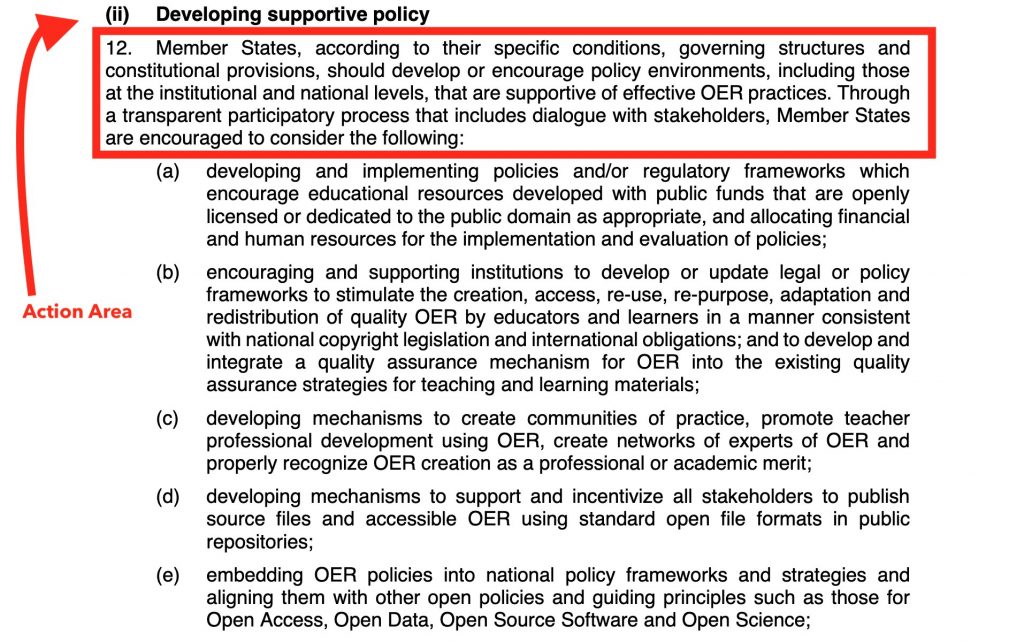
WHAT IF?
Attach examples, resources, commentary to expand on meaning of specific words
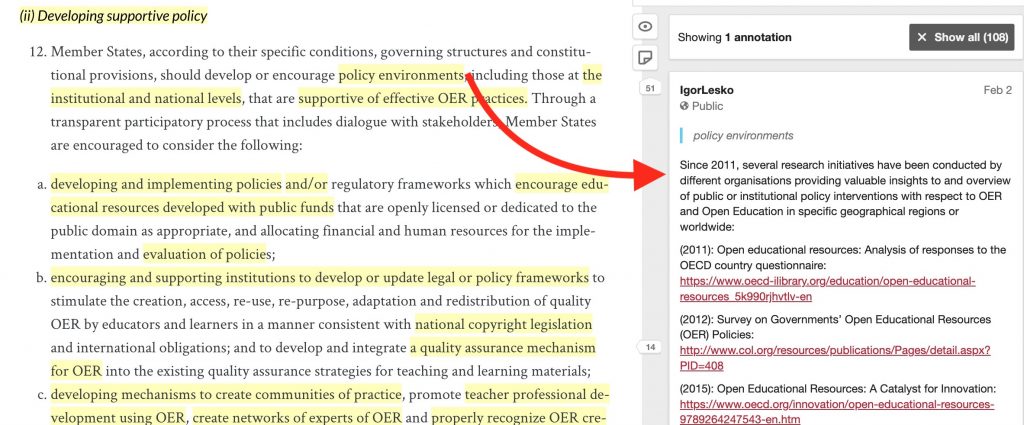
Annotation
Hardly a brand new innovation
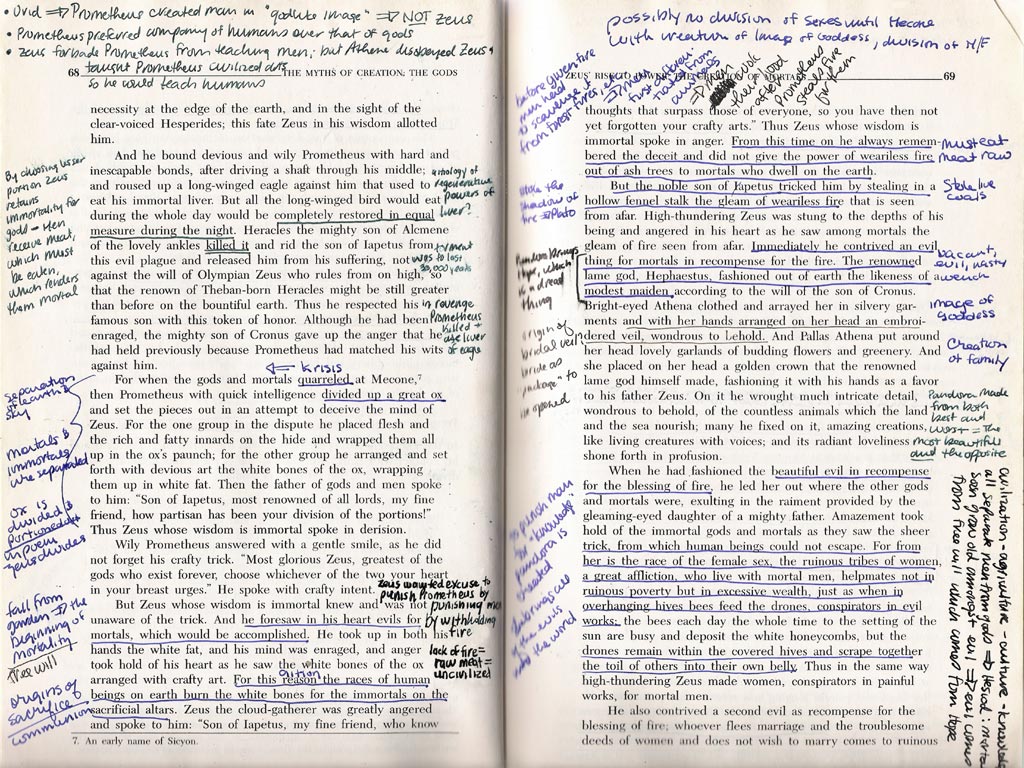
About Annotation
- About Annotation (in this book)
- Anything written shared by Remi Kalir
- Kalir, R. and Garcia, A, (2021). Annotation. Cambridge, MA: MIT Press. https://mitpress.mit.edu/books/annotation
- Hypothes.is (web annotation)
For the researcher, Hypothesis organizes, for say one random person :
Enough Talk, Let’s Annotate
This page is enabled for annotation!
Annotate 1-2-3
- How do you know? Look in the upper right corner a gray button with a
<symbol. - If you have a Hypothes.is account, log in. If not you can create one here.
- Click the yellow text to add a reply to an existing annotation OR slect new text, then click Annotate.
- Try it now.
Hello OER22 participants! Are you ready to annotate? Maybe try replying and introducing yourself, see how it works as a conversational layer.
What are your experiences with annotation (outside of the digital space)? In their book Annotation, Kalir and Garcia offer examples of every day acts such as charting a child’s growth on a doorway, adding notes to a family recipe card, even creating meme images, that all are acts of annotation. Can you think of your own everyday activities that might be considered annotation? Where do you see it in the world around you?
If you have experience using Hypothes.is, please share a bit how you might use it in your teaching, for research, or any other useful means.
Annotating the OER Recommendation at OE Global
From 2021-2022
- Theme of the 2021 OE Global Online Conference (September 2021)
- Let’s Annotate the UNESCO Recommendation on OER (OEG Connect)
- And also for the 2022 OE Global In Person Congress in Nantes (May 2022)
- Bridging Activities: Three Days of Focus Sessions (OEG Connect) on each action area)
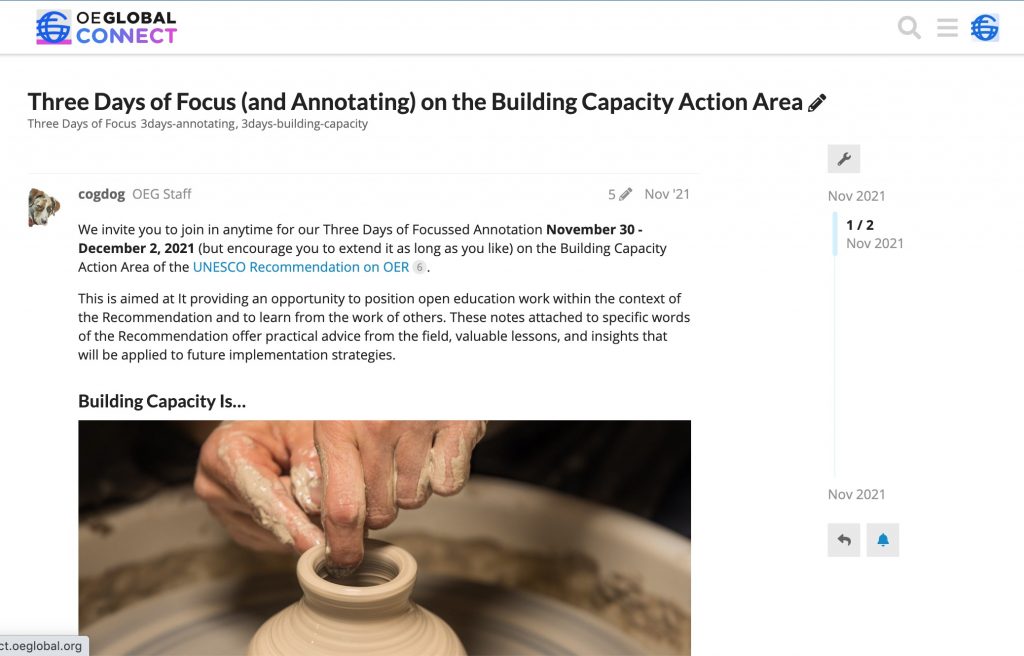
CROWDLAAERS Activity
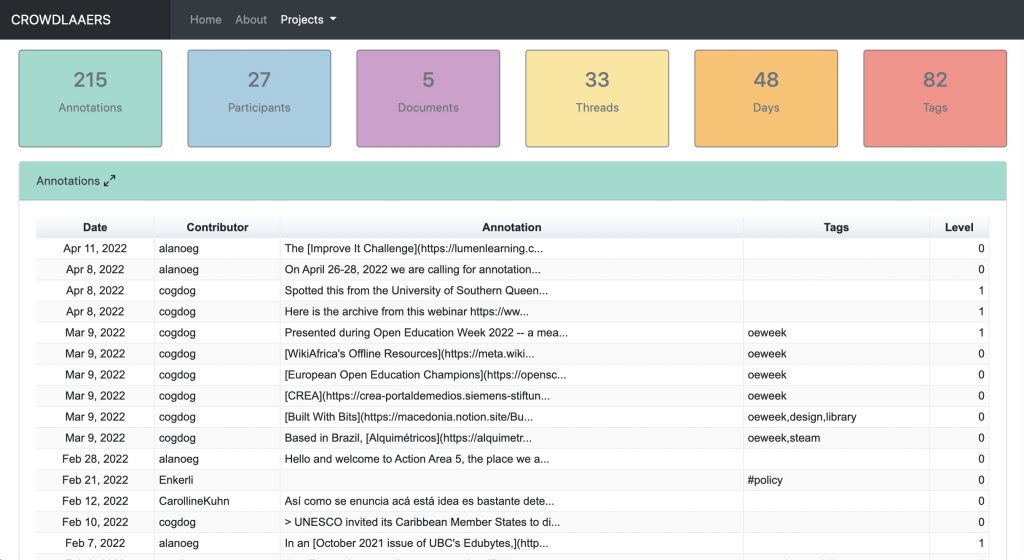
Let’s Jam!
Can you help add context, meaning, examples to this document with web annotation?
https://connect.oeglobal.org/t/3289
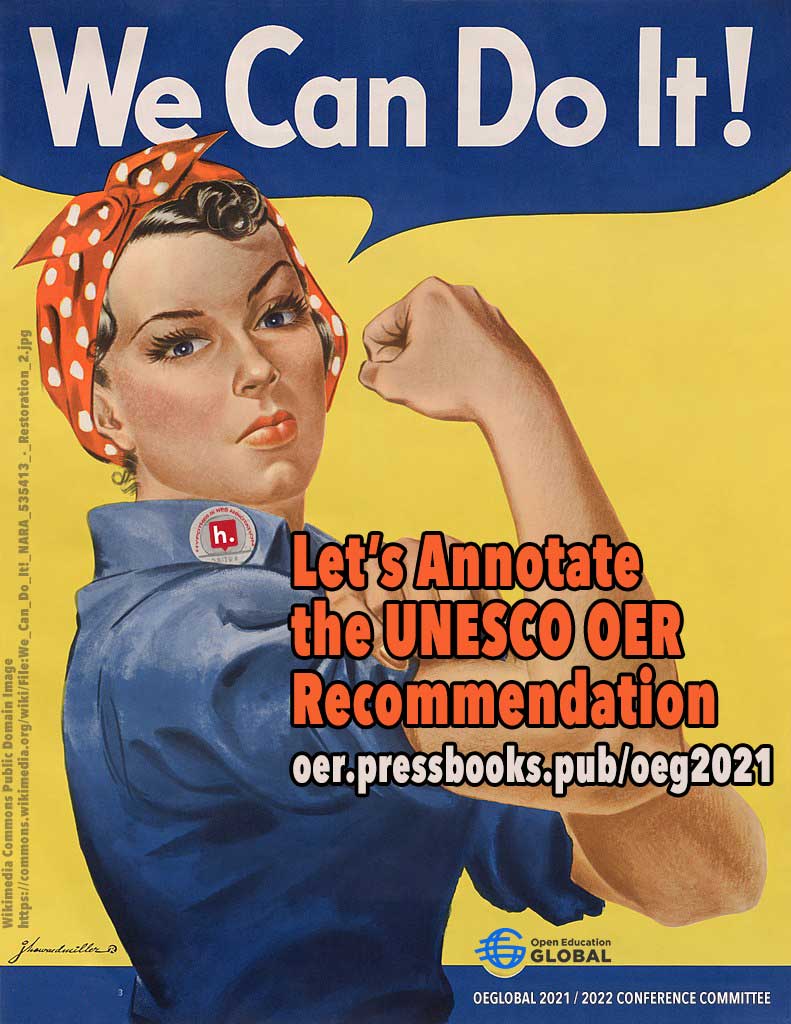
Annotate Now!
- Focus on the Inclusive & Equitable OER Action Area (direct link to this area, and an OER22 Welcome)
- Three Paths of Annotation
- Scan existing notes and add replies
- Start with a specific resource, example, or question you associate with the action area, look for the relevant words to anchor it to
- Scan the text and look for words lacking annotation that you can contribute to
- Or annotate any other part of the document, as well as in other languages
-
Recommendation on Open Educational Resources (OER) — English
-
Recommandation sur les Ressources éducatives libres (REL) — French
-
Recomendación sobre los Recursos Educativos Abiertos (REA) — Spanish
-
Рекомендация об открытых образовательных ресурсах (ООР) — Russian
-
التوصية الخاصة ﺑﺎلموارد التعليمية المفتوحة — Arabic, in development
-
关于开放式教育资源的建议书 – Chinese
-
- And if it helps, we offer a digital badge for annotating the OER Recommendation
Annotating an Action Area in 5 minutes
Focus on (and Annotating of) the Inclusive & Equitable OER Action Area – Loom Video.
Comments? Feedback?
Use your annotation super powers…
I have been trying everything I know to get more involvement with this effort. Please help me understand what it might take to get more people involved.

Does it make sense? Is it too difficult? Can it add value to this document? What kinds of annotation here would be useful to the open education community? What would be useful to you? Does this inspire ideas for any ways you might use web annotation? What would a penguin have to say about this?
Thank you OER22!
